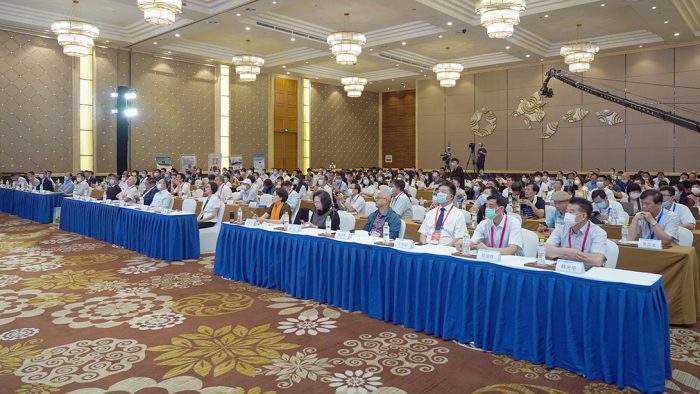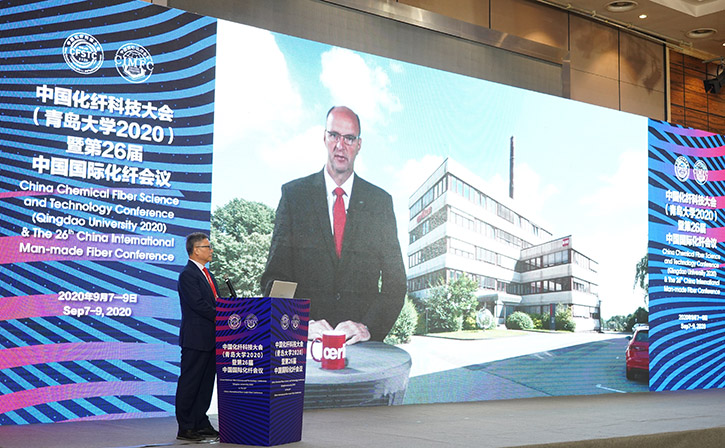At the 26th China International Manmade Fiber Conference (CIMFC 2020), September 8-9 in Qingdao City, Shandong Province, China, experts and executives said that the manmade fiber industry’s long-term strategy, technological innovations and industrial upgrading were strong responses to the challenges brought by the coronavirus (COVID-19) pandemic.
Attendees & event details
The CIMFC 2020 was for the first time held jointly with the China Chemical Fiber Science and Technology Conference (CFSTC). CFSTC was an annual conference that started in 2016 in order to focus on technological innovations for the manmade fiber industry. The CFSTC 2020 was first scheduled for June 22-24, but was postponed due to the COVID-19 pandemic.
In the previous edition of CIMFC held in September 2019, more than 600 people attended the conference. However, this September, the number of attendees was reduced to 180, due to COVID-19. The CIMFC 2020 was also broadcast on the internet to minimize the impact of the pandemic. On the first day of the conference, CIMFC 2020 received a total online views of more than 20,000, according to the organizers.
Fiber professionals from nine countries and regions spoke during the two day event. The speakers were primarily from mainland China, with representatives from Germany, Japan, South Korea, Thailand, Taiwan, India, Pakistan, and Belgium who spoke online.
The conference was organized by the China National Textile & Apparel Council (CNTAC), the China Chemical Fibers Association (CCFA), the China Textile International Exchange Center (CTIEC), and the Qingdao University. The Qingdao municipal government and Oerlikon also sponsored the event.
COVID-19: manmade fiber contributes to the response
Mr. Gao Yong, secretary-general of CNTAC, said China’s large capacity of manmade fibers and textiles had played a key role in combating the COVID-19 pandemic that started in early 2020. “By August, China had exported 130 billion facemasks and 1.3 billion units of the medical-protective garment to tackle the pandemic. Now China still exports 700 million to 900 million facemasks every day,” said Gao.
COVID-19: long-term strategy wins
Georg Stausberg, CEO of the Oerlikon Manmade Fibers segment, co-hosted a speech through the internet with his colleague Wang Jun, president of Oerlikon China, who physically attended the CIMFC 2020. Their topic was “The Challenges and Opportunities of the Manmade Fiber Industry.”
“Oerlikon has successfully combated the challenges from the pandemic,” said Stausberg. He said Oerlikon had confirmed orders into 2023 because the manmade fiber companies had set up a long-term strategy for their investment, which counteracted the short-term fluctuations of the industry, such as the COVID-19 pandemic in the first half of 2020.
“The reason that manmade fiber machines have been doing well this year is that manmade fiber companies have integrated a full industrial chain, extending their production up to the petrochemical section, long before the outbreak of the COVID-19 pandemic. [As a result], now they can better control their profits for their global business,” explained Stausberg.

Such an example includes the Zhejiang, China-based Hengyi Group, founded in 1974 as a small textile company and entered the production of manmade fibers, mostly polyester fibers, in the 1990s. Hengyi had extended its industrial chain to the production of pure terephthalic acid (PTA), the main raw material of polyethylene terephthalate (PET), since the early 2000s.
The extension of the industrial chain helped Hengyi combated the financial crisis that started in 2008. In 2010, PTA surpassed its fiber products, contributing to 54% of its total sales of more than 30 billion yuan ($4.4 billion) and over 80% of its total profits.
Since the early 2010s, Hengyi has further extended its industrial chain up to oil refinery. The company’s sales reached 200 billion yuan ($29.6 billion) in 2019, becoming one of the 50 largest private companies in China.
Hengyi has started a new plan every five years since 1996. The company’s 6th Five Year Plan, which will start in 2021, targets at an annual sales of 500 billion yuan ($73.9 billion) by 2024 based on its “Oil Plus” strategy, which creates a business model that integrates the production, trading, finance, and logistics of petroleum and chemicals, according to Mr. Qiu Yibo, president of Hengyi.
COVID-19: advanced fibers win
Some of the sunrise manmade fiber varieties helped them stand out under the impact of the COVID-19 pandemic, according to manufacturers. “The pandemic hasn’t changed the fact that carbon fiber is a sunrise industry,” said Mr. Lu Zhaojun, General Manager of Weihai Guangwei Group Co., Ltd. (Guangwei). He said the production scale of carbon fibers in China would keep growing in the coming years.
Mr. Zhang Guoliang, president of Zhongfu Shenying Carbon Fiber Co., Ltd. (Zhongfu), shared similar views. “China’s production of carbon fibers is still far less than its demands,” said Zhang. He said Zhongfu would grow through four main segments to meet the fast-growing demands in the future: the first is to develop new products and set up new lines that specifically cater for the domestic demands; the second is to expand production capacity with upgraded products and improved technologies; the third is to push the smart production and automation; and the fourth is the green production that protects the environment.
Mr. Chi Haiping, General Manager of Yantai Tayho Advanced materials Co., Ltd (Tayho), also highlights how advanced fibers saved a company. Tayho was originally Yantai Spandex Plant, founded in 1986. The company was one of the earliest spandex producers in China. However, its spandex products reported losses several years in a row during the 2000s. So the company started producing meta-aramid in 2004 and para-aramid in 2011 to turn losses to profits. In 2019, although the spandex division still accounted for 60% of its total sales of 2.5 billion yuan ($370 million), spandex only had a gross profit of 0.16% and contributed to 0.5% of its total profits. On the other hand, Tayho’s aramid products had a gross profit rate of 44.2% and made up 99.5% of its total profits.
Future opportunities
Stausberg also said he believed that recycling, automation, and digitalization are important opportunities for the manmade fiber industry in the post-COVID-19 era. Currently, Oerlikon is trying to achieve its mission of “Clean Technology Smart Factory” through a series of projects in China and several other countries based on the innovative possibilities supported by the automation and digitalization efforts, added Stausberg.
Mr. Duan Xiaoping, president of CCFA, also highlighted the importance of automation in his speech. “The COVID-19 pandemic has caused a labor shortage in China. Manufacturers are forced to use more machines to replace workers,” said Duan. He concluded the trends and opportunities for the manmade fiber industry in China’s 14th Five-Year Period (2021-2025) would include the green technologies that tackle environmental problems such as plastic microbeads, smart manufacturing and automation starting from machines replacing workers, as well as competition for talents and other core advantages.
Mr. Kenichi Tomiyoshi, Director-General of the Japan Chemical Fibers Association (JCFA), on the other hand, stressed the recycling issues of the manmade fiber industry in his remote speech for the CIMFC 2020. He said that JCFA had founded a new panel that focuses on the sustainable developments of the manmade fiber industry since May 2020. The panel’s main targets include creating a fiber-to-fiber recycling system, developing biomass-derived and biodegradable fibers, tackling the problems of plastic microbeads from manmade fibers. “Recycling economy will still be one of the most important problems in the post-COVID-19 era,” he concluded.
CCFA has set up several funds with manmade fiber companies to support the recycling, technological innovations, and long-term developments for the manmade fiber industry. These funds include the Hengyi Fund and the Luyu Fund.



